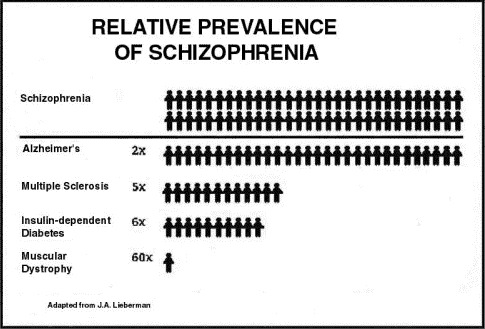Schizophrenia in the World

Even though there is ongoing studies to help those with schizophrenia there is still a lot of stigma that surrounds the disease. When dealing with schizophrenia in other countries people aren’t so quick to diagnose the disorder, instead they may think of the voices as deceased family members (Kolodny, 2014). From some changing the way these voices are perceived could help them with schizophrenia. Although, the support of the voices doesn’t occur worldwide. Many people remain uneducated about mental health diseases which allows those to continue suffering with little to no support from family members. Having negative stigma towards those with schizophrenia affects their recovery. It puts up a barrier for their treatment because when their actions are rejected they tend to feel segregated and powerless (Barbato, n.d.)
Elaenor Longden explains in this video how she dealt with schizophrenia in her life. She struggled with a system that didn't know how to help her deal with her condition. Elaenor was ab
Schizophrenia is a mental health disorder that affects more than 21 million people worldwide (WHO, 2016). Although it is not one of the most prevalent diseases, it is seen as one of the major contributors to the global burden of disease (Saha, 2005). Schizophrenia usually starts in young adulthood around the ages of 16-30. There are three categories of symptoms to describe the condition. Positive symptoms include behaviors not generally seen in healthy people such as: hallucinations, delusions (firming believing in false beliefs or suspicions), thought disorders, and movement disorders. Negative symptoms deal with disruption of normal emotions; this includes reduced feelings of pleasure, reduced speaking, a “flat affect” and difficulty beginning and sustaining activities. Cognitive symptoms are less common and usually subtle but they can include: problems with working memory, trouble focusing, and poor executive functioning (NIH, 2016).
The two contributing factors of developing schizophrenia are related to a person’s environment and genetics. There is not a specific explanation to what causes it but it has been shown that around ninety percent of those that are suffering from this disorder are from low and middle income countries (WHO, 2016). Other studies have concluded that poor and homeless are more likely to develop this disorder, which deals with the environments they live in (Bhugra, 2005).
Schizophrenia is a mental health disorder that can be treated by medication and psychosocial support. The reason there is still a worldwide issue is because most people don’t have access to treatment. In order to help those suffering there needs to be more education available, trained healthcare personnel, supporting families, etc (WHO, 2016). With these treatments many people are able to live high functioning lives, there are some cases where people experience relapses but continuing with treatment throughout their lives helps (Parekh, 2017). Research has continued to find the genetic causes and to develop a medication that treats more than just psychosis. By using genomic technology it has been discovered that there are 108 locations in the genome associated with the risk for schizophrenia (Meade, 2014).

